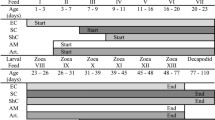Abstract
Larvae of the Siamese fighting fish Betta splendens were reared on the mass-cultured small freshwater rotifer Brachionus angularis Laos strain (UTAC-Lao), Paramecia sp., and Artemia as live food sources. Larvae fed live food were found to have a significantly high survival rate (97.5–100%) 18 days after hatch (DAH) in comparison to the control unfed larvae, which died by 12 DAH. Rotifer-fed larvae were found to grow faster than paramecia-fed larvae. The fastest growth rate was observed in larvae fed a combination of rotifer and Artemia, with growth in these larvae increasing by 282% by 18 DAH [total length (TL) 11.3 ± 1.2 mm] relative to body measurements taken 3 DAH. The next fastest growth rate was observed in rotifer-fed larvae, with a 158% increase in growth observed by 18 DAH (TL 7.6 ± 0.5 mm). The paramecia-fed larvae were found to grow by only 54.3% (TL 4.6 ± 0.1 mm) during the same period.



Similar content being viewed by others
References
Yin XW, Niu CJ (2008) Effect of pH on survival, reproduction, egg viability and growth rate of five closely related rotifer species. Aquat Ecol 42:607–616
Leutbecher C (2000) A routine method of DNA-extraction from extremely small metazoans, e.g. single rotifer specimens for RAPD-PCR analyses. Hydrobiologia 437:33–137
Gilbert JJ, Burns CW (1999) Some observations on the diet of the backswimmer, Anisops wakefieldi (Hemiptera: Notonectidae). Hydrobiologia 412:111–118
Pourriot R, Rougier C (1997) Reproduction rates in relation to food concentration and temperature in three species of the genus Brachionus (rotifera). Ann Limnol 33:23–31
Ogata Y, Tokue Y, Yoshikawa T, Hagiwara A, Kurokura H (2011) A Laotian strain of the rotifer Brachionus angularis holds promise as a food source for small-mouthed larvae of freshwater fish in aquaculture. Aquaculture 312:72–76
Slamet B, Hutapea JH (2004) First successful hatchery production of Napoleon wrasse at Gondol Research Institute for Mariculture, Bali. Aquac Asia 9:37
Olivotto I, Holt SA, Carnevali O, Holt GJ (2000) Spawning, early development, and first feeding in the lemonpeel angelfish Centropyge flavissimus. Aquaculture 253:270–278
Wullur S, Sakakura Y, Hagiwara A (2009) The minute monogonont rotifer Proales similis de Beauchamp: Culture and feeding to small mouth marine fish larvae. Aquaculture 293:62–67
Lim LC, Dhert P, Sorgeloos P (2003) Recent developments in the application of live feeds in the freshwater ornamental fish culture. Aquaculture 227:319–331
Ogata Y, Morioka S, Sano K, Vongvichith B, Eda H, Kurokura H, Khonglaliane T (2010) Growth and morphological development of laboratory-reared larvae and juveniles of the Laotian indigenous cyprinid Hypsibarbus malcolmi. Ichthyol Res 57:389–397
Monvises A, Nuangsaeng B, Sriwattanarothai N, Panijpan B (2009) The Siamese fighting fish: well-known generally but little-known scientifically. Sci Asia 35:8–16
Puello-Cruz AC, Velasco-Blanco G, Martinez-Rodriguez IE, Felix-Ramos E, Voltolina D (2010) Growth and survival of Siamese fighting fish, betta splendens, larvae at low salinity and with different diets. J World Aquacult Soc 41:823–828
Shirota A (1970) Studies on mouth size of fish larvae. 2. Specific characteristics of upper jaw length. Bull Jpn Soc Sci Fish 44:1171–1177
Westerfield M (1995) The zebrafish book. A guide for the laboratory use of zebrafish (Danio rerio), 3rd edn. University of Oregon Press, Eugene
Acknowledgments
We wish to thank Naoki Mizuno (Fisheries Laboratory, The University of Tokyo) for providing helpful advice on fish breeding and larval rearing which was vital for our study.
Author information
Authors and Affiliations
Corresponding author
Rights and permissions
About this article
Cite this article
Ogata, Y., Kurokura, H. Use of the freshwater rotifer Brachionus angularis as the first food for larvae of the Siamese fighting fish Betta splendens . Fish Sci 78, 109–112 (2012). https://doi.org/10.1007/s12562-011-0420-1
Received:
Accepted:
Published:
Issue Date:
DOI: https://doi.org/10.1007/s12562-011-0420-1




